Oral History - Rhoda Love
Date: July 19, 2004
Length: 85:18 minutes
Location: Love Home in Eugene, Oregon
Interviewer: Elizabeth Uhlig, Archivist, Lane Community College
Rhoda Love was one of the first botany instructors at Lane. She taught biology and botany at Lane from 1966-1975 and 1986-1995. The Rowe-Love Herbarium was named in her honor in 2004.
For a transcript of the oral history or to listen to the recorded interview, contact Lane Community Archives or click on the links below. |
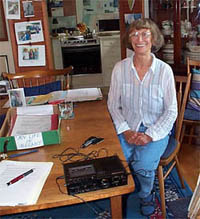
Rhoda Love during the oral history interview in the dining room of her home, July 19, 2004. |
Here are excerpts from her oral history describing the teaching of botany at Lane followed by a summary of the contents of her oral history.
Glenn Heiserman and the Botany Program at Lane
[Glenn Heiserman] was the first botanist. ... Freeman and I did not start that herbarium; it was not our idea to have a botany program there; that Glenn Heiserman got that all started. And he was a person with views much like Freeman's and mine. He was the first one to purchase materials that are needed for starting a herbarium - the herbarium cases, the special paper, the presses, blotters, cardboards - all the things that you use in the field to collect. He was the first to get his students starting collecting, and the first to collect himself. And I think he bought a set, just so there'd be some herbarium sheets, I think he bought a set from one of the biological supply companies which will supply a beginning herbarium with a set, maybe 25, 30, 50 sheets that have been collected around the country, just so that you have something to show the students and have a nucleus of a herbarium. So that was all his work.
|
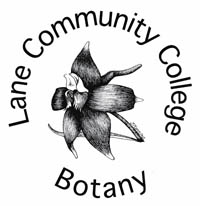 |
Field Trips
 Rhoda talks about taking student on field trips. (MP3, 1:14 min, 1.13MB.) Rhoda talks about taking student on field trips. (MP3, 1:14 min, 1.13MB.)
"I was always eager to get them out, so every opportunity I could I scheduled field trips all during the spring term and also during the autumn term. ... We went in the local area - Mt. Pisgah, right around the campus which is a wonderful botanizing area. Fern Ridge, West Eugene Wetlands, Amazon Park - places that you could get to in a two-hour class.
And then on the weekends, I conceived of what I called an "Ocean to the Desert Transcept of Oregon." In other words, from the sea, through the Willamette Valley, up over the |
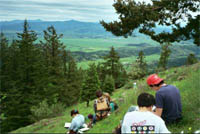
Field trip at Spencer's Butte, 1993, Photo by Rhoda Love |
Cascades, to the high desert, but of course it couldn't all be done in one weekend, and I believe Gail is still continuing with this pattern. So we saw all of that flora. And it made sense to the students. They could see how the flora changed, they could see how plants are adapted to their niche. It helped them to learn not only the names, but to learn the ecology of their state."
The field trips were usually so busy ... that there wasn't very much time for collecting. And, of course, I have a no-collecting rule for my classes. ... I did not require a student collection. I had begun to have a very strong conservation ethic... They were mostly trips in which you would name plants. I would tell the students, I want you to organize your notebook, each time we stop I want you to indicate where we are, a little description of the ecosystem, is it a Douglas fir forest, what is it, a rocky headland, then I'll start naming plants - family, genus, species, and common name, interspersed with a little ecology for each species and a little description of the family. So they came back with a lot of information to digest from those field trips.
|
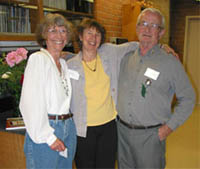
Rhoda Love, Gail Baker, Freeman Rowe, at dedication of Rowe-Love Herbarium,
May 14, 2004.
Photo by Clay Gautier |
Naming of the Rowe-Love Herbarium
 Rhoda Love talks about the naming of the herbarium. (MP3, 0:45 min, 709 KB.) Rhoda Love talks about the naming of the herbarium. (MP3, 0:45 min, 709 KB.)
It's a huge honor to have a herbarium named for you and, there are so many deserving botanists who have not had that honor. So, I think Gail [Baker, instructor of biology and botany, director of the Herbarium] did something wonderful for Freeman and me, and I'm so glad to have my name linked with his. ... And as she said that night [of the dedication on May 14, 2004] that those of us who came before her had started a pattern of teaching there that has turned out remarkable graduates, and they have been successful and they have gone far in their field. And that of course, when she came, she continued along improving the courses but following, in general, the same rigorous pattern that we started. |
|
Summary of Interview - Part 1 - 44:41 minutes |
| 00:00 |
Introduction |
| 00:20 |
Was born and raised in Seattle; talks about parents and high school |
| 01:00 |
Attended Seattle public schools for elementary and high school; went to the University of Washington as an English major and then switched to science; studied education for a teacher's certificate |
| 01:50 |
As a child she was always interested in flowers; has many photographs of her and flowers taken by her father when she was a child |
| 02:16 |
Was encouraged to major in English in high school, but changed her major to biology and education after taking her first botany class from C. Leo Hitchcock at the University of Washington in 1952; had good teachers and a great education |
| 03:20 |
"Botany genealogy" - who your teachers were and who your students are - is important. In the U.S. there is an evolutionary tree of botanists which can be traced back to Asa Gray (1810-1888) at Harvard. |
| 04:08 |
C.L. Hitchcock was an outstanding teacher. Describes him and his classes. RL patterned her teaching after his with quizzes every week and frequent field trips. |
| 05:40 |
Her specialty was taxonomy [the science of classification and naming of organisms]. To prepare for a career as a high school teacher of general biology, she also studied chemistry, zoology, and genetics. |
| 07:15 |
Taught science and math at Seattle schools, including Ingraham High School. Returned to UW for Master's degree. |
| 09:00 |
Moved to San Diego with husband, Glenn, who took a teaching job at San Diego State College. She was a lecturer and lab instructor in beginning biology in the biology department at SDSC for two years; also taught at the San Diego Evening College. |
| 11:10 |
Awarded two National Science Foundation grants for summer programs for high school teachers when she was at Ingraham High School in Seattle. One program was in the radiation department at UW where she was taught radiation biology. |
| 13:22 |
The other grant was at Lake Itasca, the head of the Mississippi River in Minnesota, where she studied field ecology and networked with other high school teachers. |
| 14:40 |
Left San Diego after 2 years; felt San Diego was too conservative. Moved to Eugene in September 1965; husband Glen got job at UO teaching American literature and rhetoric. |
| 16:15 |
Began teaching at LCC in January 1966 at the old Bethel School. |
| 18:40 |
Taught in the evening school at Bethel and also on the new 30th Avenue campus. Conditions were less than ideal; students were struggling; no lab facilities. |
| 20:25 |
Became involved in designing the new science building on the new campus; lobbied to have classrooms with windows and a cold storage room. Taught part-time in the daytime. |
| 23:00 |
Describes working with colleagues: Freeman Rowe - both took courses in plant anatomy at the UO. |
| 25:00 |
Describes teaching about evolution at LCC. There was a division in the department over evolution between those who were uneasy with evolution and did not introduce it into their biology teaching and others who felt that evolution was the foundation of biology. |
| 27:05 |
Glen Heiserman was the first botanist at LCC who started the botany program at LCC. He purchased cases, presses, special paper, herbarium sheets, and other materials for the herbarium. He was the first to get students involved in collecting and in collecting himself. |
| 29:05 |
Jay Marston was an enthusiastic and great teacher who offered courses, such as one on edible plants, that the students adored. He was involved in the Mt. Pisgah Arboretum wildflower and mushroom shows. |
| 31:40 |
Field trips - She was eager to get students out in the spring and autumn terms to learn about the Willamette Valley ecosystem. |
| 33:25 |
Classes were a mix of typical biology majors and returnees - such as former loggers who wanted to return to the woods to work, but needed to know their biology and botany. There were also students from the UO studying in the spring taxonomy classes |
| 34:40 |
On the field trips, they went to areas around the campus that they could reach in a two-hour class - to Mt. Pisgah, Fern Ridge, West Eugene wetlands, Amazon Park. The weekend "ocean to desert" field trips covered territory from the Pacific Ocean, to the Willamette Valley, to the Cascades, and the high desert. They made multiple stops at different elevations to see how plants change, and how they adapted to their niche; they learned the names of plants as well as the ecology |
| 36:40 |
Field trips were not collecting trips. She had a no-collecting rule for her classes and did not require student collections. She had a strong conservation ethic and only collected if there was a plant that was missing from the LCC herbarium. |
| 37:35 |
Field trip activities included indicating location, description of ecosystem (Douglas fir forest, rocky headland, etc.), name of plant (family, genus, species, common name), and the ecology for each species. |
| 38:15 |
Collecting trips - she always collected around Eugene, on family trips in the U.S. and in New Zealand and Europe. She has more specimens in LCC's collection than anyone else. She never collected in huge numbers and was more concerned with filling out the herbarium's collection in terms of diversity. |
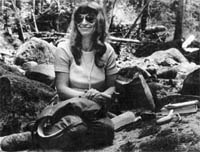
Rhoda Love on field trip to French Pete Creek, 1974.
Photo by Charles Muson |
| 39:40 |
Describes the collecting process - using a plant press, keeping a field notebook, and mounting specimens on herbarium sheets. |
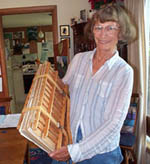
Rhoda Love with a plant press, 2004
|
| 41:20 |
Describes a herbarium sheet - the leaves, flowers, or fruit of a plant and a label with relevant information about the plant. Now there are labels with "Rowe-Love Herbarium, Lane Community College, Eugene, Oregon". |
| 43:00 |
Rhoda Love felt honored and humbled to have the herbarium named after her and Freeman Rowe. They started a pattern of teaching that has turned out so many remarkable and successful graduates. |
| 44:40 |
End of cassette tape, Side A. |
| |
Summary of Interview - Part 2 - 40:37 minutes |
| 00:00 |
Cold storage unit was also named after Rhoda Love. A cold storage unit is used to hold the flowers and plants needed for classroom instruction. Gail Baker was successful in getting a cold storage unit for botanists and zoologists in the new Science Building |
| 2:40 |
Took a leave from LCC for about a decade. In 1975 she made a career change into environmentalism. She studied at the UO and received her PhD in1980. |
| 5:38 |
Dissertation topic was an ecological one: insect feeding / insect predation on Willamette Valley hawthorns. She did research at the Nature Conservancy's Cogswell-Foster Reserve north of Coburg . |
| 11:50 |
With her husband Glen she wrote a book and edited essays to teach students about the environmental crisis. |
| 13:10 |
Was administrative assistant at Mt. Pisgah Arboretum and helped to start their education program by writing a guide to the Arboretum and brochures about the nature trails. |
| 13:30 |
Began teaching again at LCC in 1986; taught until her retirement in 1995 |
| 15:40 |
Was involved with Mt. Pisgah Arboretum wildflower shows from 1981, and held many positions with the Native Plant Society since the early 1970s. |
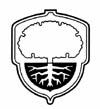
Mt. Pisgah Arboretum
|
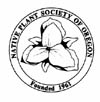 |
| 16:50 |
After retirement from LCC, she volunteered at the herbarium at Oregon State University which was revising the Oregon Flora, a book which describes the plants of the region. In addition to describing hawthorns and other plants for the Flora, she became editor of the Flora Newsletter. |
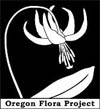 |
| 23:10 |
Wrote biographies of northwest botanists and collectors. She is co-writer with Arthur Kruckeberg on a book about the early collectors. She has become an expert on early botanists and loves the research. She is now researching and writing about Lewis Henderson's trip to Alaska with fourteen students in 1932. |
| 26:54 |
Continues to research and write about Lewis Henderson. |
| 27:35 |
Also writes about women botanists: Lila Leach from Barlow Oregon; Helen Gilkey whose career was at the herbarium at OSU; and also lesser known Oregon women botanists. |
| 32:35 |
Describes changes in the field of botany in the last 40 years. There weren't many changes until molecular biology was born. Since Asa Gray, botany, the science of taxonomy, and the naming of plants was pretty stable. Taxonomy has undergone a tremendous change due to the ability to extract the DNA from the chloroplasts and compare different species. |
| 36:40 |
Describes the lack of a field botany program at Clatsop Community College and the lack of someone who can go into the field and identify the local plants and study the ecosystems. |
| 38:25 |
Discusses her important contributions to the field and to LCC. She feels her most important contribution was turning out the hundreds of trained students and their friendships. Other important contributions have been designing the education program at Mt. Pisgah Arboretum, and her environmental work. |
| 40:35 |
End of interview |
For a transcript of the oral history or to listen to the recorded interview, contact Lane Community Archives.
Related web sites:
- Online Exhibits - web exhibits featuring photographs and excerpts from oral histories and other reminscences.
-
- Gail Baker Home Page - Biology/Botany instructor at Lane, includes links to local botanical organizations and events
|











